Related Research Articles
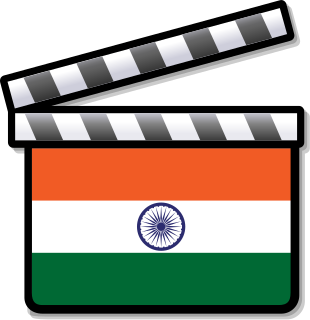
Hindi cinema, popularly known as Bollywood and formerly as Bombay cinema, is the Indian Hindi-language film industry based in Mumbai. The popular term Bollywood, used to refer to mainstream Hindi cinema, is a portmanteau of "Bombay" and "Hollywood". The industry is part of the larger Indian cinema—the world's largest by number of feature films produced, along with the Cinema of South India and other Indian film industries.

Dilwale Dulhania Le Jayenge, also known by the initialism DDLJ, is a 1995 Indian Hindi-language musical romance film written and directed by Aditya Chopra in his directorial debut and produced by his father Yash Chopra. Released on 20 October 1995, the film stars Shah Rukh Khan and Kajol. The plot revolves around Raj and Simran, two young non-resident Indians, who fall in love during a vacation through Europe with their friends. Raj tries to win over Simran's family so the couple can marry, but Simran's father has long since promised her hand to his friend's son. The film was shot in India, London, and Switzerland, from September 1994 to August 1995.

Kuch Kuch Hota Hai also known as KKHH or K2H2, is a 1998 Indian Hindi-language romantic comedy drama written and directed by Karan Johar and produced under Dharma Productions. It stars the popular on-screen pair of Shah Rukh Khan and Kajol in lead roles along with Rani Mukerji. While, Salman Khan is seen in an extended cameo. It also features Sana Saeed in supporting role. The plot combines two love triangles set years apart. The first half covers friends on a college campus, while the second tells the story of a widower's young daughter who tries to reunite her dad with his old best friend.

Mohabbatein is a 2000 Indian Hindi-language romantic drama film that was written and directed by Aditya Chopra and produced by Yash Chopra of Yash Raj Films. The film stars Amitabh Bachchan, Shah Rukh Khan, and Aishwarya Rai, and newcomers Uday Chopra, Shamita Shetty, Jugal Hansraj, Kim Sharma, Jimmy Sheirgill, and Preeti Jhangiani. It narrates the story of Narayan, the strict principal of Gurukul college whose daughter Megha, commits suicide after he opposes her relationship with Raj, a music teacher at the college. The story follows Raj aiding with three Gurukul students and their love interests to rebel against Narayan's intolerance of love.

Karan Johar, often informally referred to as KJo, is an Indian filmmaker and television personality, who primarily works in Hindi cinema. He has launched the careers of several successful actors under his own Dharma Productions. The recipient of several accolades, including a National Film Award and six Filmfare Awards, he has been honored with Padma Shri, the country's fourth highest civilian award by the Government of India in 2020.
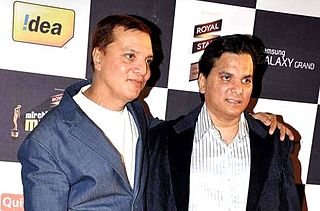
Jatin–Lalit are an Indian film music director duo consisting of Jatin Pandit and his brother Lalit Pandit. They have written the widely popular scores for films such as Yaara Dildara, Khiladi, Jo Jeeta Wohi Sikandar, Kabhi Haan Kabhi Naa, Raju Ban Gaya Gentleman, Khamoshi: The Musical, Dilwale Dulhania Le Jayenge, Fareb, Yes Boss, Jab Pyaar Kisise Hota Hai, Kuch Kuch Hota Hai, Sarfarosh, Ghulam, Pyaar Kiya To Darna Kya, Pyaar To Hona Hi Tha, Khoobsurat, Mohabbatein, Kabhi Khushi Kabhi Gham, Hum Tum, Chalte Chalte and Fanaa.
Manmohan Singh is an Indian film director and cinematographer. He is a director of Punjabi films and cinematographer of Bollywood films. In the past he had frequently collaborated with Yash Chopra, for whom he shot Chandni (1989), Darr (1993), Dilwale Dulhania Le Jayenge (1995), Dil To Pagal Hai (1997), and Mohabbatein (2000). Besides his Bollywood career as a cinematographer, he is also known as a pioneering director in Punjabi cinema. He directed his first Hindi film, Pehla Pehla Pyar in 1994 and first Punjabi film Jee Ayan Nu in 2003. He received "Lifetime Achievement Award" in PTC Punjabi Film Awards 2019.
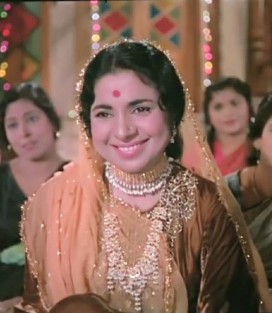
Achala Sachdev was an Indian actress who appeared in classic films of Hindi language film industry. She was from Peshawar and started her career as a child actor. She later became known for mother and grandmother roles in Hindi films. Her most memorable roles were as Balraj Sahni's wife in Waqt (1965) and Kajol's grandmother in Dilwale Dulhania Le Jayenge (1995).

Parmeet Sethi is an Indian actor, director, producer and writer. He is best known for portraying Kuljeet Singh in his debut in Aditya Chopra's directorial debut Dilwale Dulhania Le Jayenge (1995).

Anupama Chopra is an Indian author, journalist, film critic and director of the MAMI Mumbai Film Festival. She is also the founder and editor of the digital platform Film Companion, which offers a curated look at cinema. She has written several books on Indian cinema and has been a film critic for NDTV, India Today, as well as the Hindustan Times. She also hosted a weekly film review show The Front Row With Anupama Chopra, on Star World. She won the 2000 National Film Award for Best Book on Cinema for her first book Sholay: The Making of a Classic. She presently critiques movies and interviews celebrities for Film Companion.
The 41st Filmfare Awards were held in 1996.
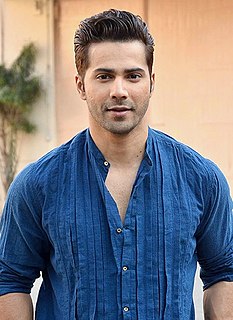
Varun Dhawan is an Indian actor who works in Hindi films. One of India's highest-paid actors, he has been featured in Forbes India's Celebrity 100 list since 2014. He has starred in 11 consecutive box-office successes between 2012 and 2018.

Maratha Mandir is a cinema hall located in Maratha Mandir Marg, Mumbai, India. It opened on 16 October 1958 and has 1000 seats. In the 1960s and 1970s, it was known for its lavish film launches, but the introduction of multiplexes diverted "class" viewers from establishment with the "masses" of the working class patronizing the theatre instead. It is currently known for holding a record after screening the film Dilwale Dulhania Le Jayenge for 1009 weeks since its release in 1995, on 19 February 2015. As of September 2019, the film has been running for a continuous 1230 weeks. This cinema hall is one of the famous landmarks in Mumbai.
Pooja Ruparel is an Indian actress who appears in Bollywood movies and TV series. She is well known for her iconic role as "Chutki" in Dilwale Dulhania Le Jayenge, one of India's most successful films. She has also acted in a number of plays, apart from being a stand-up comedian and a singer.

Kajol is an Indian actress who is known for her work in Hindi films. She made her screen debut in the 1992 film Bekhudi. She was noted for her performance and went on to sign the 1993 commercially successful thriller Baazigar opposite Shah Rukh Khan. She starred in the 1994 film Udhaar Ki Zindagi, which earned her critical acclaim. This was followed by a role in Yeh Dillagi alongside Akshay Kumar and Saif Ali Khan. Kajol featured in five films in 1995. She appeared briefly in the thriller Karan Arjun, and played Simran, an NRI in Aditya Chopra’s romance Dilwale Dulhania Le Jayenge, both of which ranked among the highest-grossing Bollywood films of the year, and the success of the latter established her career in Bollywood. As of 2021, Dilwale Dulhania Le Jayenge is the longest-running Indian film. Also in 1995, she appeared in the box-office flops Hulchul and Gundaraj. Her only screen appearance of 1996 was in Bambai Ka Babu, a financial failure.
Shashank Khaitan is an Indian film writer, director and producer who works in Hindi films. He is known for his association with Dharma Productions.
Mehndi Laga Ke Rakhna is a popular 1995 Hindi song from Bollywood movie Dilwale Dulhania Le Jayenge sung by Lata Mangeshkar and Udit Narayan.

Dilwale Dulhania Le Jayenge is a 2002 Indian book written by the journalist and film critic Anupama Chopra. It details the production of and analysing the plot and well commercial performance of Aditya Chopra's 1995 romantic drama of the same name, the longest-running film in Indian cinema history.
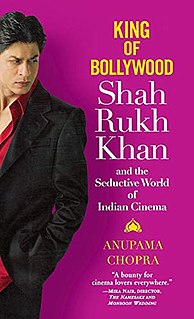
King of Bollywood is a biography by the film critic and journalist Anupama Chopra, chronicling the life and career of Shah Rukh Khan. The book describes his personal life such as his birth in 1965 in New Delhi and his marriage to Gauri Chibber in 1991. The book also outlines his career as an actor, film producer, and television presenter. It was published by Grand Central Publishing on 9 August 2007 and became a commercial success. Its critical reception was positive, with Chopra's writing garnering appreciation.
References
- ↑ Lutgendorf, Philip (2005). "Sex in the Snow: The Himalayas as Erotic Topos in Popular Hindi Cinema". Himalaya: The Journal of the Association for Nepal and Himalayan Studies. Association for Nepal and Himalayan Studies. 25 (1): 29–38. ISSN 2471-3716 . Retrieved 7 February 2021.
- 1 2 Rao, Shakuntala (2010). ""I Need an Indian Touch": Glocalization and Bollywood Films". Journal of International and Intercultural Communication. 3 (1): 12. doi: 10.1080/17513050903428117 . ISSN 1751-3057.
- ↑ Chandrasekhar, Anand (18 June 2019). "On the trail of the first Indian film shot in Switzerland". Swissinfo . Swiss Broadcasting Corporation . Retrieved 6 February 2021.
- 1 2 Mansky, Jackie. "The Hills Are Alive With the Sound of Bollywood". Smithsonian . Retrieved 7 February 2021.
- 1 2 Bhalla 2019, Indian Bollywood in Switzerland.
- 1 2 3 Letzing, John (22 July 2013). "Bollywood's Big-Screen Love Affair With Switzerland Fades to Black". The Wall Street Journal . ISSN 0099-9660 . Retrieved 9 February 2021– via www.wsj.com.
- ↑ "Swiss tourism industry owes a debt to Indian actress Sridevi". Swissinfo . Retrieved 8 February 2021.
- ↑ "Bollywood's long-standing love affair with Switzerland". House of Switzerland. Presence Switzerland . Retrieved 10 February 2021.
- ↑ "Switzerland attempts a makeover to seduce young Indians". Swissinfo . Retrieved 8 February 2021.
- ↑ Rajan (17 December 2014). "50 years of Indian cinema in Switzerland". Newly Swissed . Retrieved 8 February 2021.
- ↑ "Indian movies as effective as Google Maps in understanding topography of Switzerland: Kovind". Business Standard . Press Trust of India. 12 September 2019. Retrieved 6 February 2021.
- ↑ "Swiss yatra". SWI swissinfo.ch. Retrieved 30 April 2021.